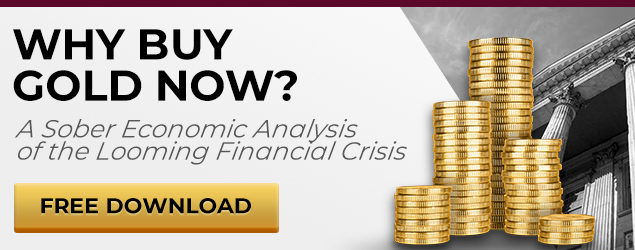Peter Schiff: Peak Inflation Is Just Wishful Thinking

As expected, the March Consumer Price Index was smoking hot with a 1.2% month-on-month increase and an 8.5% annual gain. But the mainstream found a silver lining in the numbers. Core inflation wasn’t quite as high as expected leading many to conclude that we’ve reached “peak inflation.” In his podcast, Peter Schiff said this is just wishful thinking.
The March CPI reflected the first impacts of the Russian invasion of Ukraine and the spiking oil prices that followed. Although the CPI was slightly above the consensus expectation, many thought it would surprise to the upside. Peter said some people were relieved the numbers weren’t even higher.
The annual CPI gain was the biggest since 1981, but Peter reminded us that this is basically comparing apples to oranges.
Forty years ago, we used entirely different CPI than we use today. And as far as I can tell, we are generally missing the mark by about half, meaning that if we use the 1981 CPI to measure the 2022 price increases, we probably would see a year-over-year rise of 17%, which is twice eight-and-a-half.”
Projections for March’s core CPI, excluding more volatile food and energy prices, were 0.5% month-on-month. It came lower, at 0.3%, which was below the range of estimates.
That was a good number as far as the markets were concerned because the core CPI didn’t go up nearly as much as thought.”
And the year-over-year core number came in at 6.5%, a little better than the expected 6.6%.
A little worse on the headline. A little better on the core. But overall, I guess the whisper numbers were that all these numbers would come in hot, and since they didn’t, the market initially was relieved.”
But even though core CPI was lower than expected, 0.3% is still a high number. If you annualize that print, it’s still 3.7% per year, almost double the Fed’s 2% target.
Peter pointed out it doesn’t make any sense to look at year-over-year core inflation if you’re going to take some solace in the fact that inflation is not so bad if we strip out food and energy.
Families can’t strip out food and energy. They can’t survive without food and energy. When food and energy prices are up year-over-year big, that’s not volatility. That’s a trend. And you can’t ignore that trend when you’re trying to calculate inflation and determine whether or not you have a problem. You have a big problem.”
Also, in a normal economy, core prices should drop as energy and food prices should rise. As people spend more on food and energy, they have less to spend on other things.
So, core prices should be falling as the food and energy prices are rising. But the reason that all prices are rising is because everybody has got more money. We’ve got more money to buy food and energy, and we’ve got more money to buy everything else. Where’s all that money coming from to buy all this stuff? It’s coming from the Federal Reserve. The Federal Reserve is creating all the inflation in the core and in the headline. It’s not Putin and it wasn’t COVID.”
We know the markets were anxious about the CPI data because all of the bond yields hit highs the night before the numbers came out. Bond traders were bracing for a hot CPI. When the numbers were relatively benign – at least not as bad as expected – the bond market rallied.
Interestingly, all of the inversions in the yield curve disappeared.
I think the significance of this un-inversion of the yield curve … I think what the bond market is potentially forecasting is that based on this so-called benign number, maybe the Fed won’t have to hike as much as people thought, and so that’s why the shorter end of the curve got an improvement because maybe the Fed won’t have to jack rates up as much.”
There could also be some sense that the Fed will push the economy into a recession sooner, again meaning the Fed won’t have to raise interest rates as high, but the long end of the curve seems to indicate the markets anticipate inflation might hang around longer.
The markets are projecting that interest rates will peak around 3.25% in 2023.
I don’t think that that’s going to be the case because I think before we get to 3.25% the economy will be in recession or will be close enough to a recession that the Fed ultimately backtracks from its rate hikes, and in fact will even return to quantitative easing. So, I don’t think we’ll ever get to that level. Remember, in 2018, the Fed couldn’t get above 2.5% before it had to backtrack and ultimately go back down to zero. And given how much more debt the economy has today than it had then, and how much more leverage there is now, it seems to me if we couldn’t take 2.5% in 2018 we can’t take 2.5% now, let alone 3.25. And so the Fed is not going to be able to get rates that high before something breaks.”
The US government ran another big budget deficit in March. It was almost quadruple expectations.
Back in the day of QE, which was just a few days ago, the Treasury could count on the Fed to buy most of that $192.7 billion. Well obviously, not only can’t the Treasury count on the Fed to buy any of that $192.7 billion, but the Fed is going to be selling billions of dollars worth of Treasuries off of its own balance sheet that has to be financed in addition to that $192.7 billion, which is why I don’t believe the Fed is going to be able to continue with quantitative tightening to the extent that it ever actually begins quantitative tightening, because the US Treasury just has too many bonds to sell and not enough buyers to step up.”
Peter noted that in 1981, the last time CPI was this high, interest rates peaked at 20%. Today, interest rates are at 0.25%. Then, we had real rates of over 6%. Today, real rates are deeply negative.
Is inflation going to peak when interest rates are at -8.25% when it took positive 6.5% to get inflation to peak in 1981? And of course, if we are measuring prices accurately, as I said earlier, we’ve got 17% inflation, which means we have -16.75 real interest rates — inflation is far more likely to accelerate than come down when you have a negative interest rate that high. Instead of being at the end of an inflationary period, we’re just beginning. … All of the people who are saying inflation has peaked they’re just saying that because they hope it’s peaked.
Call 1-888-GOLD-160 and speak with a Precious Metals Specialist today!
Buka akaun dagangan patuh syariah anda di Weltrade.
Source link







